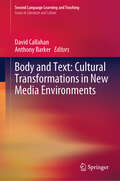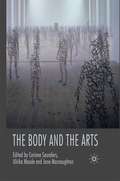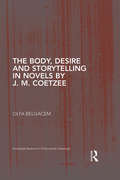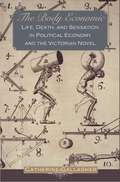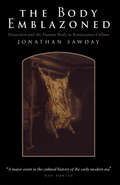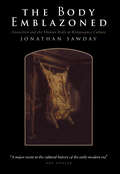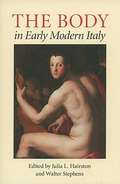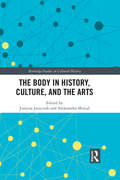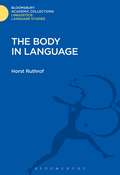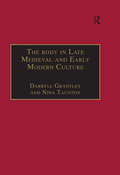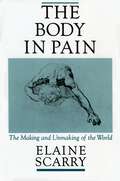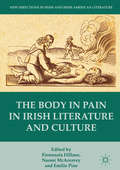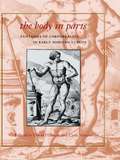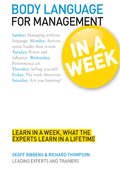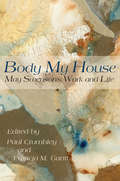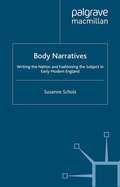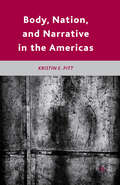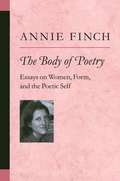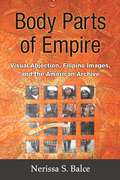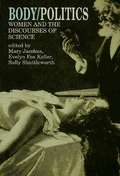- Table View
- List View
Body and Text: Cultural Transformations in New Media Environments (Second Language Learning and Teaching)
by David Callahan Anthony BarkerThis book presents a collection of academic essays that take a fresh look at content and body transformation in the new media, highlighting how old hierarchies and canons of analysis must be revised. The movement of narratives and characterisations across forms, conventionally understood as adaptation, has commonly involved high-status classical forms (drama, epic, novel) being transformed into recorded and broadcast media (film, radio and television), or from the older recorded media to the newer ones. The advent of convergent digital platforms has further transformed hierarchies, and the formation of global conglomerates has created the commercial conditions for ever more lucrative exchanges between different media. Now source texts can move in any direction and take up any configuration, as emerging interacting fan bases drive innovation and new creative and commercial possibilities are deployed. Moreover, transformation may be not just a technology-driven creative practice and response, but at the very centre of the thematic worlds developed in those forms of story-telling which are currently popular: television series, video games, films and novels. The magic transformation of “your” money into “their” money is paralleled in contemporary media and culture by the centrality of transformation of one product to another as a media industry practice, as well as the transformation of bodies as a major theme both in the ensuing media products and in people’s identity practices in daily life.
The Body and the Arts
by Corinne SaundersThe Body and the Arts focuses on the dynamic relation between the body and the arts: the body as inspiration, subject, symbol and medium. Contributors from a variety of disciplines explore this relation across a range of periods and art forms, spanning medicine, literature from the classical period to the present, and visual and performing arts.
The Body, Desire and Storytelling in Novels by J. M. Coetzee
by Olfa BelgacemAsserting that Coetzee’s representation of the body as subject to dismemberment counters the colonial representation of the other’s body as exotic and erotically-charged, this study inspects the ambivalence pertaining to Coetzee’s embodied representation of the other and reveals the risks that come with such contrapuntal reiteration. Through the study of the narrative identity of the colonial other and her/his body’s representation, the book also unveils the author’s own authorial identity exposed through the repetitive narrative patterns and characterization choices.
The Body, Desire and Storytelling in Novels by J. M. Coetzee (Routledge Research In Postcolonial Literatures Ser.)
by Olfa BelgacemAsserting that Coetzee’s representation of the body as subject to dismemberment counters the colonial representation of the other’s body as exotic and erotically-charged, this study inspects the ambivalence pertaining to Coetzee’s embodied representation of the other and reveals the risks that come with such contrapuntal reiteration. Through the study of the narrative identity of the colonial other and her/his body’s representation, the book also unveils the author’s own authorial identity exposed through the repetitive narrative patterns and characterization choices.
The Body Economic: Life, Death, and Sensation in Political Economy and the Victorian Novel
by Catherine GallagherThe Body Economic revises the intellectual history of nineteenth-century Britain by demonstrating that political economists and the writers who often presented themselves as their literary antagonists actually held most of their basic social assumptions in common. Catherine Gallagher demonstrates that political economists and their Romantic and early-Victorian critics jointly relocated the idea of value from the realm of transcendent spirituality to that of organic "life," making human sensations--especially pleasure and pain--the sources and signs of that value. Classical political economy, this book shows, was not a mechanical ideology but a form of nineteenth-century organicism, which put the body and its feelings at the center of its theories, and neoclassical economics built itself even more self-consciously on physiological premises. The Body Economic explains how these shared views of life, death, and sensation helped shape and were modified by the two most important Victorian novelists: Charles Dickens and George Eliot. It reveals how political economists interacted crucially with the life sciences of the nineteenth century--especially with psychophysiology and anthropology--producing the intellectual world that nurtured not only George Eliot's realism but also turn-of-the-century literary modernism.
The Body Economic: Life, Death, and Sensation in Political Economy and the Victorian Novel
by Catherine GallagherThe Body Economic revises the intellectual history of nineteenth-century Britain by demonstrating that political economists and the writers who often presented themselves as their literary antagonists actually held most of their basic social assumptions in common. Catherine Gallagher demonstrates that political economists and their Romantic and early-Victorian critics jointly relocated the idea of value from the realm of transcendent spirituality to that of organic "life," making human sensations--especially pleasure and pain--the sources and signs of that value. Classical political economy, this book shows, was not a mechanical ideology but a form of nineteenth-century organicism, which put the body and its feelings at the center of its theories, and neoclassical economics built itself even more self-consciously on physiological premises. The Body Economic explains how these shared views of life, death, and sensation helped shape and were modified by the two most important Victorian novelists: Charles Dickens and George Eliot. It reveals how political economists interacted crucially with the life sciences of the nineteenth century--especially with psychophysiology and anthropology--producing the intellectual world that nurtured not only George Eliot's realism but also turn-of-the-century literary modernism.
The Body Emblazoned: Dissection and the Human Body in Renaissance Culture
by Jonathan SawdayAn outstanding piece of scholarship and a fascinating read, The Body Emblazoned is a compelling study of the culture of dissection the English Renaissance, which informed intellectual enquiry in Europe for nearly two hundred years. In this outstanding work, Jonathan Sawday explores the dark, morbid eroticism of the Renaissance anatomy theatre, and relates it to not only the great monuments of Renaissance art, but to the very foundation of the modern idea of knowledge. Though the dazzling displays of the exterior of the body in Renaissance literature and art have long been a subject of enquiry, The Body Emblazoned considers the interior of the body, and what it meant to men and women in early modern culture. A richly interdisciplinary work, The Body Emblazoned re-assesses modern understanding of the literature and culture of the Renaissance and its conceptualization of the body within the domains of the medical and moral, the cultural and political.
The Body Emblazoned: Dissection and the Human Body in Renaissance Culture
by Jonathan SawdayAn outstanding piece of scholarship and a fascinating read, The Body Emblazoned is a compelling study of the culture of dissection the English Renaissance, which informed intellectual enquiry in Europe for nearly two hundred years. In this outstanding work, Jonathan Sawday explores the dark, morbid eroticism of the Renaissance anatomy theatre, and relates it to not only the great monuments of Renaissance art, but to the very foundation of the modern idea of knowledge. Though the dazzling displays of the exterior of the body in Renaissance literature and art have long been a subject of enquiry, The Body Emblazoned considers the interior of the body, and what it meant to men and women in early modern culture. A richly interdisciplinary work, The Body Emblazoned re-assesses modern understanding of the literature and culture of the Renaissance and its conceptualization of the body within the domains of the medical and moral, the cultural and political.
The Body In Early Modern Italy (PDF)
by Julia L. Hairston Walter StephensHuman bodies have been represented and defined in various ways across different cultures and historical periods. As an object of interpretation and site of social interaction, the body has throughout history attracted more attention than perhaps any other element of human experience. The essays in this volume explore the manifestations of the body in Italian society from the fourteenth through the seventeenth centuries. Adopting a variety of interdisciplinary approaches, these fresh and thought-provoking essays offer original perspectives on corporeality as understood in the early modern literature, art, architecture, science, and politics of Italy. An impressively diverse group of contributors comment on a broad range and variety of conceptualizations of the body, creating a rich dialogue among scholars of early modern Italy. Contributors: Albert R. Ascoli, University of California, Berkeley; Douglas Biow, The University of Texas at Austin; Margaret Brose, University of California, Santa Cruz; Anthony Colantuono, University of Maryland, College Park; Elizabeth Horodowich, New Mexico State University; Sergius Kodera, New Design University, St. Pölten, Austria; Jeanette Kohl, University of California, Riverside; D. Medina Lasansky, Cornell University; Luca Marcozzi, Roma Tre University; Ronald L. Martinez, Brown University; Katharine Park, Harvard University; Sandra Schmidt, Free University of Berlin; Bette Talvacchia, University of Connecticut
The Body in History, Culture, and the Arts (Routledge Studies in Cultural History #72)
by Justyna Jajszczok Aleksandra Musia 322The aim of this book is to explore the body in various historical contexts and to take it as a point of departure for broader historiographical projects. The chapters in the volume present the ways in which the body constitutes a valuable and productive object of historical analysis, especially as a lens through which to trace histories of social, political, and cultural phenomena and processes. More specifically, the authors use the body as a tool for critical re-examination of particular histories of human experience, and of societal and cultural practices, thus contributing to the burgeoning area of body history in terms of both specific case studies as well as historiography in general.
The Body in History, Culture, and the Arts (Routledge Studies in Cultural History #72)
by Justyna Jajszczok Aleksandra MusiałThe aim of this book is to explore the body in various historical contexts and to take it as a point of departure for broader historiographical projects. The chapters in the volume present the ways in which the body constitutes a valuable and productive object of historical analysis, especially as a lens through which to trace histories of social, political, and cultural phenomena and processes. More specifically, the authors use the body as a tool for critical re-examination of particular histories of human experience, and of societal and cultural practices, thus contributing to the burgeoning area of body history in terms of both specific case studies as well as historiography in general.
The Body in Language (Linguistics: Bloomsbury Academic Collections)
by Horst RuthrofThis book opposes the position that meanings can be explained by way of intralinguistic relations, as in structural linguistics and its successors, and rejects definitional descriptions of meaning as well as naturalistic accounts. The idea that we are able to live by strings of mere signifiers is shown to rest on a misconception. Ruthrof also attempts an explanation of why arguments grounded in a post-Saussurean view of language, as for instance certain feminist theories, find it so difficult to show how precisely the body can be reclaimed as an integral part of linguistic signs. In reinstating the body in language, Ruthrof draws on Peirce, Husserl, Heidegger, Wittgenstein and Derrida, cognitive linguistics and rhetoric, as well as on the writings of Helen Keller.
The Body in Late Medieval and Early Modern Culture
by Nina TauntonTaking as its chronological starting-point the female body of late medieval devotional literature, the volume moves on to a consideration of the representation of gendered bodies in later literature. It then proceeds to examine sixteenth-century occupational orderings of the (male) body in education, the civil service and the army, and involves explorations into a variety of rituals for the purification, ordering and disciplining of the flesh. It includes enquiries into the miraculous royal body, demon bodies, the 'virtual' body of satire, and ends the late seventeenth century with dramatic representations of the diseased body, and the grotesque bodies of travellers’ tales as signifiers of racial difference. It pushes forward post-modern notions of the body as a site for competing discourses. It provides new dimensions to fantasies, rituals and regulations in narratives ('fictions') of the body as identifications of forms of knowledge unique to the early modern period. Each of the essays sheds new light on how these late medieval and early modern narratives function to produce specialized and discrete languages of the body that cannot be understood simply in terms, say, of religion, philosophy or physiology, but produce their own discrete forms of knowledge. Thus the essays materially contribute to an understanding of the relationship between the body and spatial knowledge by giving new bearings on epistemologies built upon pre-modern perceptions about bodily spaces and boundaries. They address these issues by analysing forms of knowledge constructed through regulations of the body, fantasies about extensions to the body and creations of bodily, psychic, intellectual and spiritual space. The essays pose important questions about how these epistemologies offer different investments of knowledge into structures of power. What constitutes these knowledges? What are the politics of corporeal spaces? In what forms of knowledge about spatial and bodily perceptions and p
The Body in Late Medieval and Early Modern Culture
by Nina TauntonTaking as its chronological starting-point the female body of late medieval devotional literature, the volume moves on to a consideration of the representation of gendered bodies in later literature. It then proceeds to examine sixteenth-century occupational orderings of the (male) body in education, the civil service and the army, and involves explorations into a variety of rituals for the purification, ordering and disciplining of the flesh. It includes enquiries into the miraculous royal body, demon bodies, the 'virtual' body of satire, and ends the late seventeenth century with dramatic representations of the diseased body, and the grotesque bodies of travellers’ tales as signifiers of racial difference. It pushes forward post-modern notions of the body as a site for competing discourses. It provides new dimensions to fantasies, rituals and regulations in narratives ('fictions') of the body as identifications of forms of knowledge unique to the early modern period. Each of the essays sheds new light on how these late medieval and early modern narratives function to produce specialized and discrete languages of the body that cannot be understood simply in terms, say, of religion, philosophy or physiology, but produce their own discrete forms of knowledge. Thus the essays materially contribute to an understanding of the relationship between the body and spatial knowledge by giving new bearings on epistemologies built upon pre-modern perceptions about bodily spaces and boundaries. They address these issues by analysing forms of knowledge constructed through regulations of the body, fantasies about extensions to the body and creations of bodily, psychic, intellectual and spiritual space. The essays pose important questions about how these epistemologies offer different investments of knowledge into structures of power. What constitutes these knowledges? What are the politics of corporeal spaces? In what forms of knowledge about spatial and bodily perceptions and p
The Body in Pain: The Making and Unmaking of the World
by Elaine ScarryPart philosophical meditation, part cultural critique, The Body in Pain is a profoundly original study that has already stirred excitement in a wide range of intellectual circles. The book is an analysis of physical suffering and its relation to the numerous vocabularies and cultural forces--literary, political, philosophical, medical, religious--that confront it. Elaine Scarry bases her study on a wide range of sources: literature and art, medical case histories, documents on torture compiled by Amnesty International, legal transcripts of personal injury trials, and military and strategic writings by such figures as Clausewitz, Churchill, Liddell Hart, and Kissinger, She weaves these into her discussion with an eloquence, humanity, and insight that recall the writings of Hannah Arendt and Jean-Paul Sartre. Scarry begins with the fact of pain's inexpressibility. Not only is physical pain enormously difficult to describe in words--confronted with it, Virginia Woolf once noted, "language runs dry"--it also actively destroys language, reducing sufferers in the most extreme instances to an inarticulate state of cries and moans. Scarry analyzes the political ramifications of deliberately inflicted pain, specifically in the cases of torture and warfare, and shows how to be fictive. From these actions of "unmaking" Scarry turns finally to the actions of "making"--the examples of artistic and cultural creation that work against pain and the debased uses that are made of it. Challenging and inventive, The Body in Pain is landmark work that promises to spark widespread debate.
The Body in Pain in Irish Literature and Culture (New Directions in Irish and Irish American Literature)
by Fionnuala Dillane Naomi McAreavey Emilie PineThis book elucidates the ways the pained and suffering body has been registered and mobilized in specifically Irish contexts across more than four hundred years of literature and culture. There is no singular approach to what pain means: the material addressed in this collection covers diverse cultural forms, from reports of battles and executions to stage and screen representations of sexual violence, produced in response to different historical circumstances in terms that confirm our understanding of how pain – whether endured or inflicted, witnessed or remediated – is culturally coded.Pain is as open to ongoing redefinition as the Ireland that features in all of the essays gathered here. This collection offers new paradigms for understanding Ireland’s literary and cultural history.
The Body in Parts: Fantasies of Corporeality in Early Modern Europe
by David Hillman Carla MazzioAn examination of how the body--its organs, limbs, and viscera--were represented in the literature and culture of early modern Europe. This provocative volume demonstrates, the symbolism of body parts challenge our assumptions about "the body" as a fundamental Renaissance image of self, society, and nation.
The Body in Parts: Fantasies of Corporeality in Early Modern Europe
by David Hillman Carla MazzioAn examination of how the body--its organs, limbs, and viscera--were represented in the literature and culture of early modern Europe. This provocative volume demonstrates, the symbolism of body parts challenge our assumptions about "the body" as a fundamental Renaissance image of self, society, and nation.
Body Language for Management in a Week: Teach Yourself (TYW)
by Richard Thompson Geoff RibbensThe ability to read people's body language and send out the right signals yourself, is crucial to anyone who wants to advance their career.Written by Geoff Ribbens and Richard Thompson, leading experts on body language, this book quickly teaches you the insider secrets you need to know to in order give a successful appraisal.The highly motivational 'in a week' structure of the book provides seven straightforward chapters explaining the key points, and at the end there are optional questions to ensure you have taken it all in. There are also cartoons and diagrams throughout, to help make this book a more enjoyable and effective learning experience.So what are you waiting for? Let this book put you on the fast track to success!
Body My House: May Swenson's Work and Life
by Paul Crumbley Patricia M. GanttThe first collection of critical essays on May Swenson and her literary universe, Body My House initiates an academic conversation about an unquestionably major poet of the middle and late twentienth century. Between the 1950s and the 1980s, May Swenson produced eleven volumes of poetry, received many major awards, was elected chancellor of the Academy of American Poets, and was acclaimed by writers in virtually every school of American poetry. Essays here address the breadth of Swenson's literary corpus and offer varied scholarly approaches to it. They reference Swenson manuscripts---poems, letters, diaries, and other prose---some of which have not been widely available before. Chapters focus on Swenson's work as a nature writer; the literary and social contexts of her writing; her national and international acclaim; her work as a translator; associations with other poets and writers (Bishop, Moore, and others); her creative process; and her profound explorations of gender and sexuality. The first full volume of scholarship on May Swenson, Body My House suggest an ambitious agenda for further work. Contributors include Mark Doty, Gudrun Grabher, Cynthia Hogue, Suzann Juhasz, R.R. Knudson, Alicia Ostriker, Martha Nell Smith, Michael Spooner, Paul Swenson, and Kirstin Hotelling Zona.
Body Narratives: Writing the Nation and Fashioning the Subject in Early Modern England
by S. ScholzBody Narratives deals with the configurations in the literature and culture of sixteenth-century England. It investigates the relationship between disciplinary discourses of the human body and political body imagery in the texts of courtly writers like Spenser, Sidney, Ralegh and others, and traces its interdependence in their narratives of national identity, imperial expansion and gender difference.
Body, Nation, and Narrative in the Americas
by K. PittThis book contextualizes 21st century representations of disappearance, torture, and detention within a historical framework of inter-American narratives. Examining a range of sources, Pitt finds a persistent focus on the body that links contemporary practices of political terror to concerns about corporality and sovereignty.
The Body of Poetry: Essays on Women, Form, and the Poetic Self (Poets On Poetry)
by Annie Ridley FinchThe Body of Poetry collects essays, reviews, and memoir by Annie Finch, one of the brightest poet-critics of her generation. Finch's germinal work on the art of verse has earned her the admiration of a wide range of poets, from new formalists to hip-hop writers. And her ongoing commitment to women's poetry has brought Finch a substantial following as a "postmodern poetess" whose critical writing embraces the past while establishing bold new traditions. The Body of Poetry includes essays on metrical diversity, poetry and music, the place of women poets in the canon, and on poets Emily Dickinson, Phillis Wheatley, Sara Teasdale, Audre Lorde, Marilyn Hacker, and John Peck, among other topics. In Annie Finch's own words, these essays were all written with one aim: "to build a safe space for my own poetry. . . . [I]n the attempt, they will also have helped to nourish a new kind of American poetics, one that will prove increasingly open to poetry's heart." Poet, translator, and critic Annie Finch is director of the Stonecoast low-residency MFA program at the University of Southern Maine. She is co-editor, with Kathrine Varnes, of An Exaltation of Forms: Contemporary Poets Celebrate the Diversity of Their Art, and author of The Ghost of Meter: Culture and Prosody in American Free Verse, Eve, and Calendars. She is the winner of the eleventh annual Robert Fitzgerald Prosody Award for scholars who have made a lasting contribution to the art and science of versification.
Body Parts of Empire: Visual Abjection, Filipino Images, and the American Archive
by Nerissa BalceBody Parts of Empire is a study of abjection in American visual culture and popular literature from the Philippine-American War (1899–1902). During this period, the American national territory expanded beyond its continental borders to islands in the Pacific and the Caribbean. Simultaneously, new technologies of vision emerged for imagining the human body, including the moving camera, stereoscopes, and more efficient print technologies for mass media. Rather than focusing on canonical American authors who wrote at the time of U.S. imperialism, this book examines abject texts—images of naked savages, corpses, clothed native elites, and uniformed American soldiers—as well as bodies of writing that document the goodwill and violence of American expansion in the Philippine colony. Contributing to the fields of American studies, Asian American studies, and gender studies, the book analyzes the actual archive of the Philippine-American War and how the racialization and sexualization of the Filipino colonial native have always been part of the cultures of America and U.S. imperialism. By focusing on the Filipino native as an abject body of the American imperial imaginary, this study offers a historical materialist optic for reading the cultures of Filipino America.
Body/Politics: Women and the Discourses of Science
by Mary Jacobus Evelyn Fox Keller Sally ShuttleworthBody/Politics demonstrates how many of the controversies in modern science involve or invoke the feminine body as their battleground. This groundbreaking collection addresses such scientific issues as artificial fertilization, the "crisis" in childbirth management,and the medical invention of "female" maladies and the debates surrounding them. In the process it makes an important attempt to remedy the traditional division between science and non-science by focusing on the interconnection of literary, social, and scientific discourses concerning the female body. The editors have brought together noted feminist scholars and critics from various fields. Contributers include Susan Bordo, Mary Ann Doane, Donna Haraway, Emily Martin, Mary Poovey and Paula A. Treichler.
